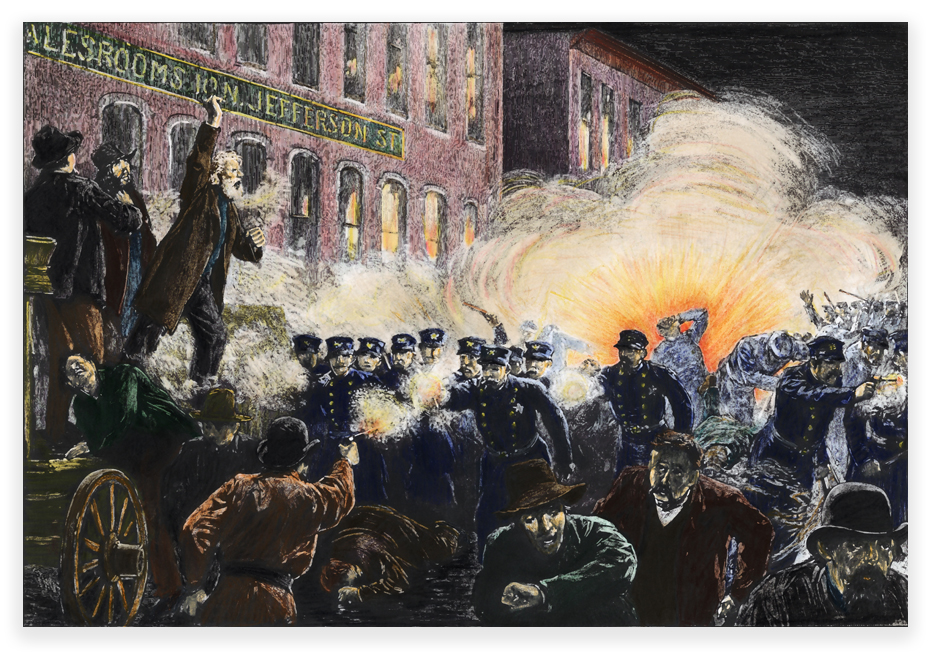We post news and comment on federal criminal justice issues, focused primarily on trial and post-conviction matters, legislative initiatives, and sentencing issues.
YOU’RE A RIOT… BUT DON’T KICK MY DOG
Ryan McMillan was a felon with a gun, conduct that violates 18 USC 922(g)(1). The district court sentenced him based in part on Ryan’s prior Minnesota conviction for third degree riot. Under Sec. 2K2.1(a)(2) of the federal sentencing guidelines, that crime of violence jacked up his sentencing range to 92-115 months.
 Rioting sounds to just about anyone to be a crime of violence. The district court thought so, determining that the riot conviction qualified because it had “as an element the use, attempted use, or threatened use of physical force against the person of another.” But Ryan did not think so, and earlier this week, the 8th Circuit agreed with Ryan.
Rioting sounds to just about anyone to be a crime of violence. The district court thought so, determining that the riot conviction qualified because it had “as an element the use, attempted use, or threatened use of physical force against the person of another.” But Ryan did not think so, and earlier this week, the 8th Circuit agreed with Ryan.
 Minn. Stat. Sec. 609.71, subd. 3 stated that “when three or more persons assembled disturb the public peace by an intentional act or threat of unlawful force or violence to person or property, each participant therein is guilty of riot third degree… “ A prior conviction like this one only qualifies as a crime of violence under the force clause if it “has as an element the use, attempted use, or threatened use of physical force against the person of another.”
Minn. Stat. Sec. 609.71, subd. 3 stated that “when three or more persons assembled disturb the public peace by an intentional act or threat of unlawful force or violence to person or property, each participant therein is guilty of riot third degree… “ A prior conviction like this one only qualifies as a crime of violence under the force clause if it “has as an element the use, attempted use, or threatened use of physical force against the person of another.”
Ever since Mathis v. United States, the courts have started their analysis of potential crimes of violence by determining whether the “categorical” or “modified categorical approach” can be used to parse the statute. If a statute provides that only one set of elements must be present to prove a violation, the courts use a “categorical” approach, asking whether the statute can theoretically be violated without employing force or the threat of force against a person. If, however, the statute has alternative elements – sort of like a Chinese restaurant menu – then it is “divisible,” and the court may look at what the defendant actually did to violate the state law, and ask itself whether the way the defendant violated the statute made it a crime of violence.
 Mathis provided a whole new set of rules for a court to use in figuring out whether a statute is divisible. First, it figures out which terms in the statute set out the elements, as opposed to the means of committing the crime. Say, for example, a statute prohibits one from “purposely insulting, taunting or kicking a person or his dog, and if anyone insults, he is guilty of a third-degree felony, if he taunts, a second-degree felony, and if his kicks, a first-degree felony.” Our hypothetical jury instructions require that the jury unanimously find whether the offensive conduct was insulting, or taunting, or kicking. But because the degree of felony (and thus punishment) is the same whether the victim is a person or a dog, the jury does not have unanimously find that the injured party was Waldo as opposed to Fido.
Mathis provided a whole new set of rules for a court to use in figuring out whether a statute is divisible. First, it figures out which terms in the statute set out the elements, as opposed to the means of committing the crime. Say, for example, a statute prohibits one from “purposely insulting, taunting or kicking a person or his dog, and if anyone insults, he is guilty of a third-degree felony, if he taunts, a second-degree felony, and if his kicks, a first-degree felony.” Our hypothetical jury instructions require that the jury unanimously find whether the offensive conduct was insulting, or taunting, or kicking. But because the degree of felony (and thus punishment) is the same whether the victim is a person or a dog, the jury does not have unanimously find that the injured party was Waldo as opposed to Fido.
Had Ryan’s prior offense been a violation of our hypothetical, the federal district court could use the modified categorical approach to find out from state court records whether he had been convicted of insulting or taunting (neither one violent conduct), as opposed to kicking (definitely violent conduct). However, because whether the victim is a human or canine is a single element (just alternative means of fulfilling that element, as opposed to kicking a cat or a trash can), the district court could not look at whether Ryan had used his size 12 on a dog versus on its owner. Any way you slice it, because the hypothetical offense could be committed without using force against a person, it would not be a crime of violence (as unfair to Rover as that may seem).
 In Ryan’s case, the Circuit noted that “the text of Minnesota’s third-degree riot statute does not provide helpful guidance as to whether the phrase ‘person or property’ lists alternative means or alternative elements, because there is a uniform punishment for commission of third degree riot. Two Minnesota appellate courts have held that to convict a defendant of a riot offense, the state only must show that the defendant was one of ‘three or more persons assembled’ and the assembly ‘disturb[ed] the public peace by an intentional act or threat of unlawful force or violence to person or property.'” The appellate panel said, “That statement of the second element of a riot offense suggests that a jury is not required to agree unanimously on whether a person or property was affected by the crime and therefore indicates that they are alternative means, not elements.”
In Ryan’s case, the Circuit noted that “the text of Minnesota’s third-degree riot statute does not provide helpful guidance as to whether the phrase ‘person or property’ lists alternative means or alternative elements, because there is a uniform punishment for commission of third degree riot. Two Minnesota appellate courts have held that to convict a defendant of a riot offense, the state only must show that the defendant was one of ‘three or more persons assembled’ and the assembly ‘disturb[ed] the public peace by an intentional act or threat of unlawful force or violence to person or property.'” The appellate panel said, “That statement of the second element of a riot offense suggests that a jury is not required to agree unanimously on whether a person or property was affected by the crime and therefore indicates that they are alternative means, not elements.”
The 8th also reviewed Minnesota’s model jury instructions, which direct that the phrase “person or property” is a list of alternative means, not elements. The model instructions list the same two elements of third degree riot, not separating “person” and “property.”
The government argued that because the disjunctive “or” separates “person” from “property,” those two terms are necessarily elements and not means. The Circuit disagreed, noting that “Mathis held that ‘or’ is not determinative one way or another. Indeed, we have concluded elsewhere that a list of alternatives was a list of means even though the statute used the word ‘or’ between the alternatives.”
Ryan will get resentenced with a substantially lower sentencing range.
United States v. McMillan, Case No. 16-2436 (8th Cir., July 24, 2017)
– Thomas L. Root

